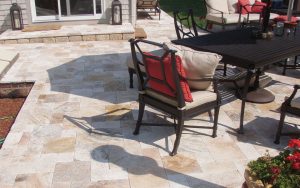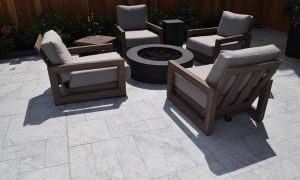WHAT IS TRAVERTINE
Travertine is a type of natural stone, like the granite in your kitchen or the marble in your bathroom. However, travertine only develops around certain types of mineral spring deposits, giving this unique type of limestone a distinctive and striking appearance.
Travertine comes in four surface finishes ( two of which are common for exterior use)
1-Brushed: Brushed travertine has a matte (non-reflective) finish due to wire brush treatment.
2-Honed: Honed travertine is halfway between matte and glossy, creating a balanced, subtly polished look.
3-Polished: Shiny and glossy, polished travertine is an eye-catching, sophisticated style.
4-Tumbled: Tumbled travertine is treated to look aged and rustic, opening a style portal to the ancient world.
Why choose travertine?
Beauty: It’s impossible to deny the lavish, classical and rustic beauty of travertine.
Durability: With proper installation, treatment and maintenance, travertine holds up against scratching and cracking and is perfect for homes with small children (or large pets!) and can last lifetime if properly cared for.
Value: Installing travertine floors can increase the value of your property ahead of a real estate sale.
Temperature: Like other stone floors, travertine tends to stay cool and does not retain heat.
How to Clean Travertine Pavers
Like other types of stone floors, travertine floors contain tiny, porous openings. Even though these openings are almost invisible to the naked eye, they are still large enough to absorb moisture and admit harmful particles of debris. This can damage the floor over time, making it more susceptible to premature discoloration, chipping, or cracking. To reduce the risk of damage, it’s important to properly treat travertine with sealers when the floors are installed. Sealant must be reapplied according to the sealer manufacturer’s instructions.
Once the sealant has been applied, cleaning and maintenance are fairly straightforward. To get the best results from travertine tile cleaning, simply wipe down or mop the tiles with a gentle, non-staining, non-abrasive cleaning solution recommended by the manufacturer. When in doubt, always consult the original manufacturer for product-specific care recommendations about what solutions you can use to clean your travertine flooring.

COLORS OF TRAVERTINE
Travertine offers a stunning variety of natural colors. The colors include variations of beige, brown, taupe and even lustrous silver grey. The stunning variety of color options prove that this stone dominates with versatility in the world of design.
COST OF TRAVERTINE
The price of travertine depends on the type you choose. Travertine can be one of the more reasonably priced stone options. Its reasonable price and rich look make travertine an affordable luxury.
DURABILITY
Travertine is not as soft as marble but not as hard as granite. It can scratch if not protected, so be careful when moving heavy objects on your travertine floors. Be conscious of the finish you choose and what kind of area you’re installing it in. Like other natural stone, travertine can lengthen its timeless beauty with proper installation and maintenance. Proper installation plays a large part in the durability of travertine.
WHERE IS TRAVERTINE SOURCED?
Travertine can be sourced from all over the world. A majority of it comes from Peru, Mexico, Turkey and China. Travertine is quarried the same way most natural stones are. It is collected in large blocks and then cut down to the desired shape.
WHAT IS MARBLE
Marble is a hard-crystalline form of limestone or dolomite rock. Colours vary from ice white to pitch black and every possible combination of colors in-between.
With its mottling and streaks, the variety of natural marble is staggering and most pieces are a true sight to behold where you can look at one piece of polished stone for hours and see multitudes of incredible features and textures within the one piece of stone.
Marble is one of the most elegant and luxurious stones available. Marble is softer than its counterpart, granite. Marble is also more susceptible to staining so insure you treat it effectively. More suitable to be used in low traffic areas.
Marble is used for many purposes such as wall, floors, landscape features, outdoor kitchens, patios, walkways, sculptures, furniture and much more. In the formation of marble, metamorphism causes variable recrystallization of the original carbonate mineral grains which results in interlocking mosaic of carbonate crystals.
What causes the veining? Since we don’t wish to devolve into a science class, why not think of the cause of veining as the result of impurities like silt, clay, oxidized iron, and more. They were in the stone originally and manifested themselves as veins over time. We will let that suffice.
Marble also offers a wide range of color possibilities. White, beige, gray, black, blue, brown, pink…OK, you get it. The colorways are clearly comprehensive and offer something for almost any design plan. Finishes are a long suit of this stone. You may choose from polished, honed, “leathered”, antiqued, and more. More, in fact, than we can give space to here.

Why choose marble?
In fact, marble is one of the best choices when it comes to heat-resistance. As a bonus, this also makes it a solid choice if you’re looking for a natural stone surround for your pool. Marble is an impressively durable material, meaning it is resistant against scratches and will last a long time in good condition
5 Great Advantages of Marble
- Affordability. Even though it looks stunningly expensive, marble can actually cost less than other natural stone
- Durability. Marble is a natural stone, so it’s more resistant to scratching, cracking and breaking than many other available natural stone materials
- Distinction
- Heat Resistance
- Longevity
